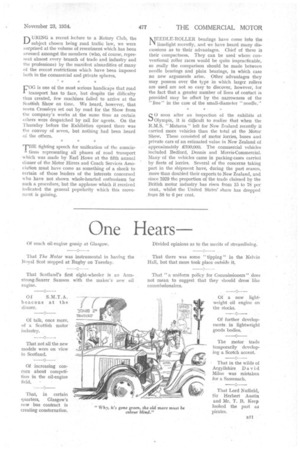Special Features of this Issue
Page 24

Page 25

If you've noticed an error in this article please click here to report it so we can fix it.
Mr. R. W. Sewill, M.A., chairman of the R.H.A., suggests a round-table conference on the Conciliation Board's findings. Page 483.
Furniture removers should read the article dealing with the
design of pantechnicons for maximum loads. Page 484 Notable features of municipal motors at the Public Health Exhibition are dealt with. Page 486.
Resumes are given of two papers read at the Cleansing Conference. Page 488.
We describe a particularly interesting form of Lockheed
clectro-hydraulic broke mechanism for trailers. Page 491.
Modern bodywork features as revealed at the Scottish Show
are discussed. Page 492.
Paris is using a new refuse collector of the hydraulic-ram
compressing type. Page 497.
Many interesting technical points were noted at the Kelvin Hall, Page 498.
Our road-test report concerns the new Dodge 3-tanner with
five-speed gearbox. Page 502.
Uses to which pitch pine can be put Ore referred to by an expert. Page 509.
URING a recent lecture to a Rotary Club, the subject chosen being road traffic law, we were surprised at the volume of resentment which has been aroused amongst the members (who, of course, represent almost every branch of trade and industry and the professions) by the manifest absurdities of many of the recent restrictions which have been imposed both in the commercial and private spheres.
FOG is one of the most serious handicaps that road transport has to face, but despite the difficulty thus created, few machines failed to arrive at the Scottish Show on time. We heard, however, that seven Crossleys set out by road for the Show from the company's works at the same time as certain others were despatched by rail for agents. On the Thursday before the Exhibition opened there was the convoy of seven, but nothing had been heard of the others.
THE fighting speech for unification of the associa4 lions representing all phases of road transport which was made by Earl licnive at the fifth annual dinner of the Motor Hirers and Coach Services Association must have come as something of a shock to certain of those leaders of the interests concerned who have not shown whole-hearted enthusiasm for such a procedure, but the applause which it received indicated the general popularity which this movement is gaining.
MEEDLE-ROLLER bearings have come into the limelight recently, and we have heard many discussions as to their advantages. Chief of these is their compactness. They can be used where conventional roller races would be quite impracticable, so really the comparison should be made between needle bearings and plain bearings, in which case no new arguments arise. Other advantages they may possess over the type in which larger rollers are used are not so easy to discover, however, for the fact that a greater number of lines of contact is provided may be offset by the narrowness of the "line" in the case of the small-diameter "needle.'
Ssoon after an inspection of the exhibits at Olympia, it is difficult to realize that when the R.M.S. " Mataroa " left for New Zealand recently it carried more vehicles than the total at the Motor Show. These consisted of motor lorries, buses and private cars of an estimated value in New Zealand of approximately £100,000. The commercial vehicles included Bedford, Dennis and Morris-Commercial. Many of the vehicles came in packing-cases carried by fleets of lorries. Several of the concerns taking part in the shipment have, during the past season, more than doubled their exports to New Zealand, and since 1929 the proportion of the trade claimed by the British motor industry has risen from 15 to 78 per cent., whilst the United States' share has dropped from 38 to 6 per cent.




























































































